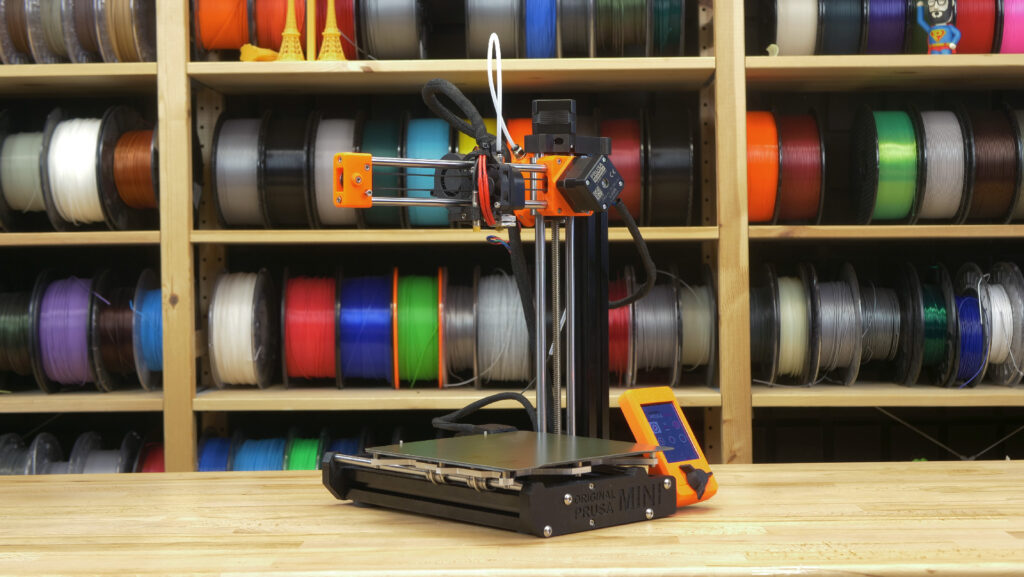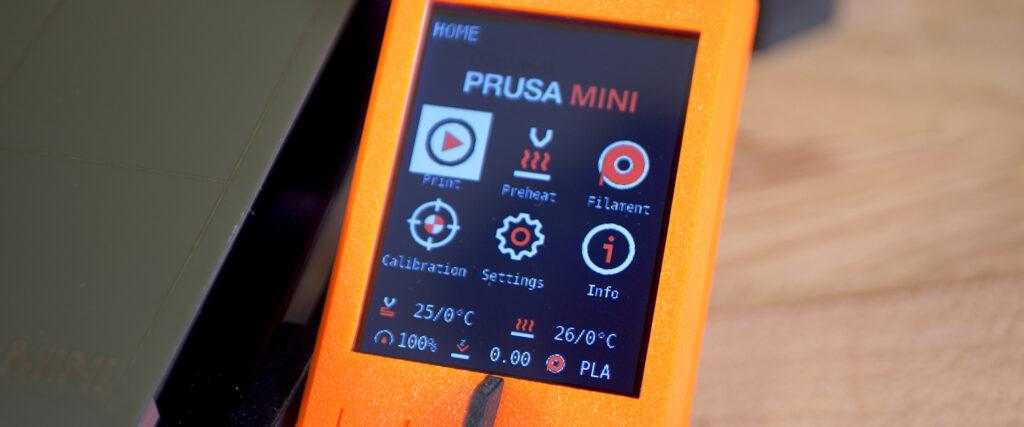
It is no secret that the entry-level 3D Printer market has been brutal. Creality, MonoPrice, and Anet continue to pump out $200 to $300 i3 clones while many companies have perished or have left the segment moving upmarket. Printerbot went bankrupt and XYZ, still one of the largest volume sellers in the low-cost space, is moving towards the enterprise market. While much of our industry derides the ‘race to the bottom’ and is scrambling upmarket, swimming against the stream, Prusa Research has released a Prusa Mini printer for $349.
After coming out of nowhere to in a few short months becoming a major player in filament with Prusament the company that sold us 150,000 FDM printers moved into SLA with a $1599 system that has forever changed the SLA market. Will this move be another brilliant move by the firm, or will the entry-level also be too competitive for them?
Prusa himself, the man, the myth, the legend has always been a contrarian, a Salmon swimming upstream. Prusa manufacturers in-house in the Czech Republic using a lot of 3D printed parts. It long didn’t capitalize on selling its printer designs, then stuck to one model for a long time without using distributors and having no presence globally. It went from no customer service to 24/7 support in 7 languages besting everyone else in the industry. Now the company is expanding into new territories fast and always selling direct while updating its model line quickly. After long being a one engineer firm, now bright-eyed bushy-tailed Prusa Research employees are taking far-reaching responsibilities to enter new markets, make new designs, create new businesses or engineer the firm itself. While long relying on its in house engineering prowess it purchased its way into the SLA market and then entered quickly. For years it did nothing on the software front and now its moving into its own download space and software add ons. Increasingly it seems that Prusa will have its own complete software solution. Often slow like a lemur and snake quick where it counts, the company is a formidable competitor. Prusa Research seems to be developing a completely integrated open-source supply chain for 3D printing. The key to the firm’s success is that even though at $999 the Prusa i3 from Prusa Research has hundreds of copies, it is still the best. Even though the i3 has been along a long time in 3D print years the company still has an incredible bang for the buck and can produce some of the best 3D printed parts out there (with a lot of love and tweaking).

If the firm could produce similar results at volume at a cheaper price point, then it will be able to dominate in that market. It is still difficult to recommend an entry-level system and there are a lot of issues with systems catching fire and being useless after a year in that segment. What if someone managed to produce a quality product for around $349? I’d recommend it, wouldn’t you? I’d shout it from the rooftops; because that is what will make our market bigger. I think that there is a very strong chance that this is a fundamentally important 3D printer that will expand our market significantly.

Filament end detection is not there but automatic bed leveling, color LCD screen that lets you see a rendering of your STL, 18×18×18 cm build volume, 200 mm/s travel speed and a compact form factor are all there. I’m a little bit worried if the print head will be stable enough when it is almost fully extended but the design and features seem solid. The Trinamic IC stepper drivers will see much more measured performance than most printers as well as much more silent operation, the company does invest where it matters. The electronics are also completely custom this time and show a future expandable package with a 32 bit STM ARM Cortex on board. Rather than direct drive, the printer has a bowden extruder which will see users battle lots of problems with the bowden tube bending and will see reduced performance for some abrasive and all flexible filaments. There are 3 thermistors and a fan sensor as well. Quite a package for $349.

There are four things I’m very excited about with the Prusa Mini: safety, service, build platform and yield. Unsafe at any speed is true for a lot of the entry-level segment in 3D printing. By turning to external power supplies which are made at high volume for laptops and the like the company sidesteps a lot of rather too adventurous electrical engineering on the printer that has lead many astray. Prusa is known for build quality and the quality control of their components and printers.QA and QC are only on the stickers for a lot of its competitors in that price segment. Most of all though service is good at Prusa and abysmal or absent at competitors. I think that service rather than the printer itself will be the key differentiator here. I can save $200 but never get an answer to an email or for $349 I can talk to someone who guarantees this thing and will make it work with me. I think as far as a value proposition goes this is all perfect. The build platform is a PEI sheet on a flexible plate that is easy to remove from a steel platform they could have a very good first layer solution that significantly outperforms most glass plates which stick too much or too little and make print removal annoying. Textured PEI sheets would also be a very handy thing.

The last thing I’m excited about is yield. For its collateral, the company repeatedly talks about the yield of this system in a print farm. We know that the Mini has been extensively tested but if this is Prusa’s internal print farm solution and is being pushed externally as such then this is significant. No one has made an optimized for print farm printer before. We know that firms are using thousands of FDM machines to manufacture parts, could the Mini be the perfect solution for them? Small form factor, high yield, high flexibility this feels like it was designed for a print farm. It smacks of being rackable and the display being removable. If contrast this to other farm contenders then it feels much more like it was meant to be used in that way and would in paradigm be similar to the HP Blade servers that you just ripped out and replaced over more expensive solutions.
Prusa prints more desktop FDM parts than anyone using them extensively on its printers. Will the company’s experience with print farms give them an edge in the nascent manufacturing with FDM market? What if it was the plucky Czech’s who come up with a winning print farm solution via this machine? Additionally, the value proposition of the machine is quite the brain teaser. So I could get ten of these or an Ultimaker 3? I could make like a print wall in my house for the cost of one machine. Which if we held ourselves to the graphic above, would let me print 200 parts per day? If I was a firm would I get an Ultimaker S5 for the reliability or buy 17 Prusa Mini because surely one of them will work? What about if I’m a college would I spend seven times more per system hoping that I don’t have any maintenance or look at output and the Prusa brand? If Prusa maintains its reliability, makes high-quality components and would make these things easy to use and maintain then this machine could dominate both the education market and manufacturing via print farms. At the same time there wasn’t a safe entry-level printer and this could be it. Seminal thing.
Subscribe to Our Email Newsletter
Stay up-to-date on all the latest news from the 3D printing industry and receive information and offers from third party vendors.
Print Services
Upload your 3D Models and get them printed quickly and efficiently.
You May Also Like
Heating Up: 3D Systems’ Scott Green Discusses 3D Printing’s Potential in the Data Center Industry
The relentless rise of NVIDIA, the steadily increasing pledges of major private and public investments in national infrastructure projects around the world, and the general cultural obsession with AI have...
3DPOD 260: John Hart on VulcanForms, MIT, Desktop Metal and More
John Hart is a Professor at MIT; he´s also the director of the Laboratory for Manufacturing and Productivity as well as the director of the Center for Advanced Production Technologies....
Etsy Design Rule Change Reduces Selection of 3D Printed Goods
Online marketplace Etsy has implemented a rule change requiring all 3D printed goods on the site to be original designs. The update to the site’s Creativity Standards states, ¨Items produced using...
E-Beam OEM Wayland Additive Partners with USC Racing to 3D Print Titanium Exhaust Collector
Every year, standards organization SAE International holds a competition called Formula SAE, in which students from both undergraduate and graduate programs design, build, and race small formula-style race cars. For...

































